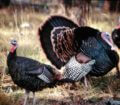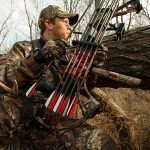Editor’s Note: Avid turkey hunter Steve Coon, a police officer from Arnold, Missouri, has been a longtime member of Mark and Terry Drury’s Drury Outdoors (www.druryoutdoors.com).
 I define a silent gobbler as a turkey that will gobble on the limb, however, not open his mouth again, as soon as he flies off the limb. Remember, I’ve said that when a turkey gobbles, he knows he’s not only calling in hunters but also natural predators like foxes, bobcats, coyotes and feral dogs. That tom also realizes that as long as he’s gobbling, the predator knows his location. If a turkey becomes silent, then neither the predators or the hunters know where the bird is. So, when I have a bird gobbling on the limb, then while he’s still in his roost tree gobbling, I want to get that bird as excited as possible. After he gobbles, I want to call back to him so aggressively and quickly that he’ll nearly choke himself trying to get another gobble out of his mouth. Just before fly-down time, I’ll shut up and not call to him. Then I’ll wait and listen for him to fly-down to the ground. Once the gobbler flies-down, I very quietly start backing away from him and then make some soft yelps as if to say, “Hey, big boy. I was right there close to you, and you wouldn’t come see me. So now, I’m going to walk on off and get a snack or find me another boyfriend to go out with this morning.”
I define a silent gobbler as a turkey that will gobble on the limb, however, not open his mouth again, as soon as he flies off the limb. Remember, I’ve said that when a turkey gobbles, he knows he’s not only calling in hunters but also natural predators like foxes, bobcats, coyotes and feral dogs. That tom also realizes that as long as he’s gobbling, the predator knows his location. If a turkey becomes silent, then neither the predators or the hunters know where the bird is. So, when I have a bird gobbling on the limb, then while he’s still in his roost tree gobbling, I want to get that bird as excited as possible. After he gobbles, I want to call back to him so aggressively and quickly that he’ll nearly choke himself trying to get another gobble out of his mouth. Just before fly-down time, I’ll shut up and not call to him. Then I’ll wait and listen for him to fly-down to the ground. Once the gobbler flies-down, I very quietly start backing away from him and then make some soft yelps as if to say, “Hey, big boy. I was right there close to you, and you wouldn’t come see me. So now, I’m going to walk on off and get a snack or find me another boyfriend to go out with this morning.”
 If the turkey gobbles and gives up his location, the hunter goes to the right of the gobbler, and I move to the left of the gobbler. We both know that the gobbler will stand there, wait for the hen to come and will be focused on the hen. I may scratch in the leaves and give some soft calls, while my hunter is moving in closer and closer to the turkey. On one particular hunt, my hunter was wearing full Mossy Oak camo (www.mossyoak.com), and he was able to move quietly and cautiously through the woods and get close enough to the turkey to take the shot. This tactic worked, because the turkey had all his attention focused on me (the hen) that was just out of sight. He was expecting to see her coming to him at any minute. That ole longbeard wasn’t thinking about a hunter slipping up on him and not calling.
If the turkey gobbles and gives up his location, the hunter goes to the right of the gobbler, and I move to the left of the gobbler. We both know that the gobbler will stand there, wait for the hen to come and will be focused on the hen. I may scratch in the leaves and give some soft calls, while my hunter is moving in closer and closer to the turkey. On one particular hunt, my hunter was wearing full Mossy Oak camo (www.mossyoak.com), and he was able to move quietly and cautiously through the woods and get close enough to the turkey to take the shot. This tactic worked, because the turkey had all his attention focused on me (the hen) that was just out of sight. He was expecting to see her coming to him at any minute. That ole longbeard wasn’t thinking about a hunter slipping up on him and not calling.
A turkey that has had some hunting pressure knows that turkey hunters use turkey calls to try to call in gobblers. They also understand that hens use hen calls to call in gobblers. Once they hear hen calls, they know that one of two things will happen. Either a hen will start coming to them, or if a turkey caller is making those calls, then that turkey hunter will try to force the gobbler to come to him. The last thing the turkey is thinking about is a turkey hunter sneaking up beside or behind him. However, let me explain. No, this tactic doesn’t always work. No turkey strategy works every time. The hunter needs to be a well-camouflaged hunter who knows how to move without being seen, how to use the terrain to get close enough to a gobbler to see the bird before the turkey spots him and how to get off a shot before the turkey sees him. This tactic is more or less a last-ditch effort to try on a gobbler that won’t talk.
 To learn more about turkey hunting, check out John E. Phillips’ print, Audible and Kindle turkey books at https://johninthewild.com/books/#turkey. For a free copy of John E. Phillips’ “The Turkey Gobbler Getter Manual,” go to https://johninthewild.com/free-books/.
To learn more about turkey hunting, check out John E. Phillips’ print, Audible and Kindle turkey books at https://johninthewild.com/books/#turkey. For a free copy of John E. Phillips’ “The Turkey Gobbler Getter Manual,” go to https://johninthewild.com/free-books/.










